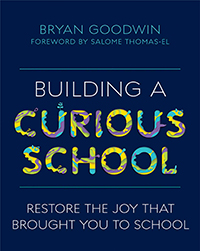In Building a Curious School, author Bryan Goodwin notes that students have greater well-being, goal orientation, and motivation when they have a passion worthy of pursuit that makes their lives meaningful. However, for many students, telling them to find their life’s passion can feel overwhelming. They may not feel like they know what they’re really passionate about yet.
So instead of asking them what they’re passionate about, it can be easier for teachers to ask students to simply identify things that hold their interest. These can be areas they want to explore more and that provide the joy of discovery or accomplishing a goal. Teachers can help students find interests and then help them pursue deep, broad learning about that area of interest. Over time, such interests can grow into passions worthy of pursuit.
The beginning of the school year is a perfect time to learn more about students’ interests. One way to do so is by using a student interest inventory, which is a brief survey teachers can use with their students to get to know their academic and extracurricular interests. Once a teacher knows more about their students, they can plan lessons and activities that tap into these interests and help their students make personal connections with their learning.
Presented below, and on the attached PDF, is a sample student interest inventory with some questions teachers can ask their students to help identify their interests. Teachers can modify this list of questions to best fit their specific grade level or subject area, their local community contexts, and student needs.
Student Interest Inventory
- What subjects or classes do you most enjoy in school?
- What topics/subjects/skills have you really enjoyed learning about in school?
- What skill have you taught yourself, on your own, outside of school?
- What was the last thing you felt curious enough about to investigate on your own?
- What kind of books, magazine articles, blogs, or websites do you read, or podcasts do you listen to, for enjoyment?
- If you could ask a remarkable person for advice, who would it be? What would you ask?
- If you could plan a field trip to anywhere, where would you go? What would you learn?
- Which of these challenges do you find most engaging? Rank them in order from 1 to 7.
- __ Figuring out how things work to fix them (for example: electronics, cars, appliances).
- __ Understanding what makes people tick—their motives, experiences, and values.
- __ Engaging in creative, imaginative thinking (creating a story, song, recipe, etc.).
- __ Helping others with problems (for example: relationships, health, emotions).
- __ Working with numbers and statistics to analyze information or solve problems.
- __ Practicing hard to get good at something.
- __ Exploring deep questions (for example: about the universe, the meaning of life, society).
After students answer these questions, invite them to review their answers, looking for themes that reveal their natural curiosity—the things that make them curious, motivated, and excited to learn. Then, ask students to write down three curiosity quests they’d like to explore in the next three months. These quests can be topics they want to learn more about, skills they want to improve on, mysteries or puzzles they want to solve, or challenges they want to overcome, to name a few. If you can then find ways to connect lessons and units with your students’ interests, they’re more likely to become engaged and interested in learning and maybe even experience joy and excitement in their studies.
Student interest surveys aren’t the only way to get to know your students’ interests, but they can be helpful. If you have a different favorite way of identifying your students’ interest, let us know in the comments.

